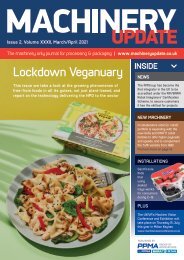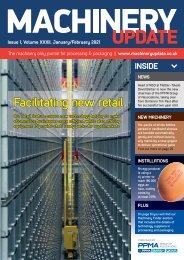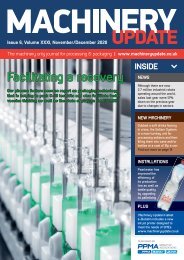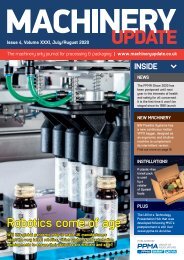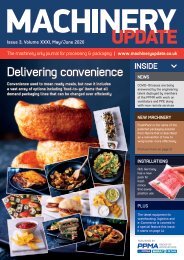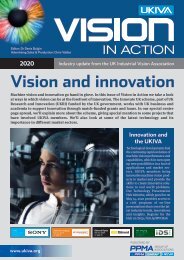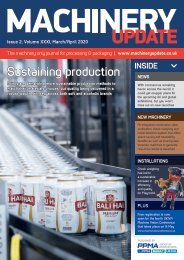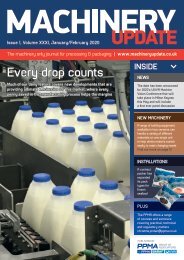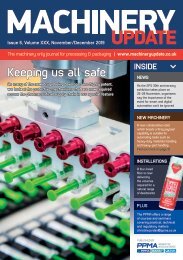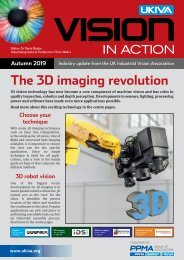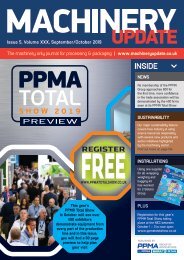MU_2018_JulyAugust-HR
You also want an ePaper? Increase the reach of your titles
YUMPU automatically turns print PDFs into web optimized ePapers that Google loves.
www.machineryupdate.co.uk JULY/AUGUST <strong>2018</strong> MACHINERY UPDATE 41<br />
Feature: Name here<br />
Vision is used across a range of industries and technologies to help deliver high quality<br />
measurable cap curve. If a cap is askew<br />
or missing, the whole crate is rejected<br />
and the defective bottle exchanged for<br />
a new one.<br />
With the sensor aligned vertically over<br />
the crate, the distance of the crown cap to<br />
the sensor is measured and evaluated at<br />
defined positions in the image. The sensor<br />
also detects if entire bottles are missing.<br />
Other errors can also be detected, such<br />
as bottles jutting further out of the crate<br />
compared to the others, due, for example,<br />
to broken glass under the bottle.<br />
Beer bottles are also often packed<br />
in cardboard cartons or boxes.<br />
A household name beer brand has<br />
recently installed a turnkey system<br />
using LWIR (thermal) and monochrome<br />
imaging for the inspection of the<br />
integrity of cartons as they emerge from<br />
the cartoning machine. Hot melt glue<br />
is applied to the flaps of the boxes and<br />
these are then folded to stick to the sides<br />
of the box to complete the assembly.<br />
By ensuring that the glue is the right<br />
temperature, and has been applied to<br />
the correct areas in the desired quantity,<br />
the manufacturer can be certain that<br />
the boxes are safe to be moved ready for<br />
subsequent transport.<br />
The LWIR camera provides a focused<br />
readout of the temperature of the glue<br />
and that it is in the right place, by<br />
imaging through the cardboard material<br />
of the box. The monochrome camera<br />
checks that the flaps have been properly<br />
formed and that the box is the correct<br />
shape. In the event of a failure, the line<br />
is automatically stopped and additional<br />
glue can be applied manually.<br />
ALUMINIUM CONTAINERS USED<br />
FOR PET FOOD<br />
Aluminium foil is widely used in<br />
containers for ready meals, takeaways<br />
and premium pet foods. All aluminium<br />
is endlessly recyclable, although<br />
aluminium foil is a different alloy to cans<br />
and is usually recycled separately with<br />
other aluminium scraps to make cast<br />
items such as engine components.<br />
A producer of thin-walled aluminium<br />
containers used for packaging pet<br />
food and other foodstuffs is now using<br />
embedded machine vision solutions to<br />
help control the quality of each container.<br />
Four pet food containers are stamped<br />
out from rolls of high quality aluminium<br />
foil at a rate of 480 containers per minute.<br />
These are then blown out onto a conveyor<br />
and transported to modular built-in<br />
inspection and stacking machines.<br />
Aluminium is relatively expensive, so<br />
the container walls must be as thin as<br />
possible, but reduced material thickness<br />
increases the risk of hole formation<br />
during the forming process.<br />
Every container is inspected using<br />
machine vision and defective ones<br />
removed before they leave the factory.<br />
Machine vision also helps identify any<br />
trends in defect formation. Four parallel<br />
lines are equipped with offset inspection<br />
stations. Each features a camera mounted<br />
below the transport track to inspect the<br />
containers using transmitted light from<br />
customised LED illumination.<br />
High quality images, produced at<br />
a rate of 120 images a minute per track,<br />
are evaluated with the results transferred<br />
to the discharge station for removal of<br />
defective containers and subsequent<br />
stacking of ‘good’ containers.<br />
T 020 8773 8111<br />
W www.ukiva.org




